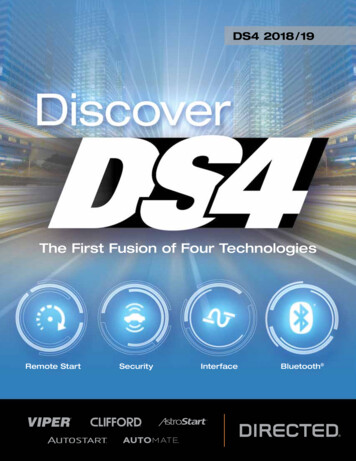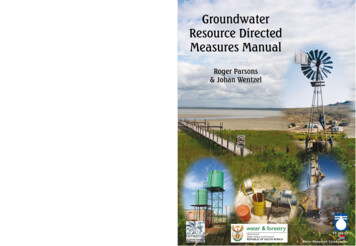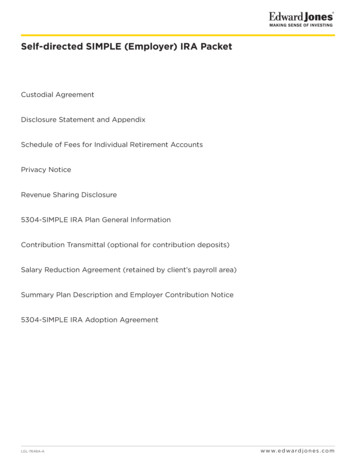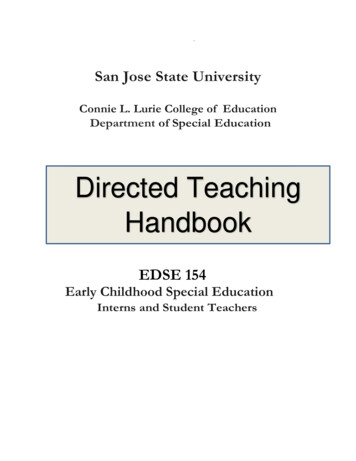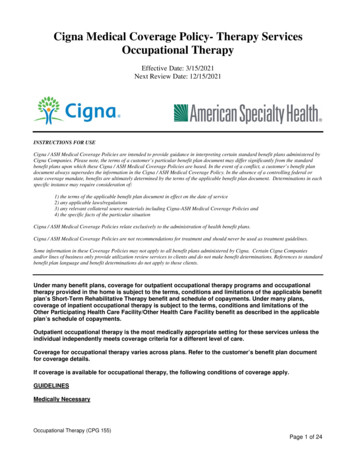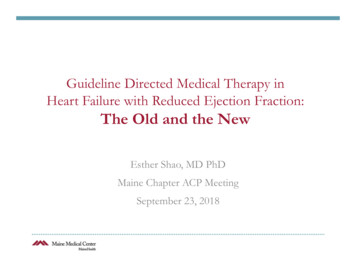
Transcription
Guideline Directed Medical Therapy inHeart Failure with Reduced Ejection Fraction:The Old and the NewEsther Shao, MD PhDMaine Chapter ACP MeetingSeptember 23, 2018
Objectives:Review the Stages of CHFFollow a case presentation while progressively discussing the components ofGuideline Directed Medical TherapyDiureticsAce-Inhibitors / ARBBeta BlockersAldosterone AntagonistsEntrestoDevice TherapiesBriefly discuss when to refer to a Heart Failure CardiologistHighlight the current activities of MMC’s Heart Failure Clinic and LVAD ProgramWhat’s new/coming in heart failure?2
Case Presentation30 y/o M transferred with respiratory failure from outside hospital History of HFrEF Diagnosis April 2014 at OSH Echocardiogram showed depressed LVEF of 10% At that time, heavy alcohol use Deemed alcoholic cardiomyopathy Discharged on lisinopril 2.5, carvedilol 12.5 BID, furosemide 40 BID Rehospitalized multiple times over the next 8 months locally Quit alcohol on his own after diagnosis and went through DTs withoutany assistance at home
More History Transferred to MMC December 31, 2014 SOB, LE edema B/L Pleural effusions, AoCKD, lactic acidosis Echocardiogram EF 10% Severe MR Moderate-Severe TR Asked by ICU team for heart transplant/LVAD evaluation.
Case PresentationInitial exam BP 82/62, HR 92, O2 sat 94% JVD to the angle of the jaw at 30 degrees NR, RR, S3. Visible LV heave. 3/6 holoSM at apex radiating to axilla Lungs clear Pulsatile liver 3 pitting edema bilaterally with cool extremitiesLabs Cr 0.93, LFTs normal, BNP 1348
Current Hospitalization
What do we do?HFrEF (biventricular), hospitalized, hypotensive, severe MR Options Medical Therapy VAD Transplant Mitral valve replacement
ACC/AHA STAGES AND CLASSES OF HEART FAILURE
Objectives:Review the Stages of CHF and Evaluation of Systolic CHFFollow a case presentation while progressively discussing the componentsof Guideline Directed Medical TherapyDiureticsAce-Inhibitors / ARBBeta BlockersAldosterone AntagonistsEntrestoDevice TherapiesBriefly discuss when to refer to a Heart Failure CardiologistWhat’s new/coming in heart failure?Highlight the current activities of the LVAD Program9
Diuretic GuidelinesClass I LOE C: Diuretics are recommended in patients with HFrEF who haveevidence of fluid retention, unless contraindicated, to improvesymptoms.How much diuretic?
Normal plasma volume results in 100%survival with almost no rehospitalizationsAndrone, et al. Americal Journal of Cardiology 15 May 2004, Pages 1254–1259
Update: CARRESS-HF Study--Changes from Baseline inSerum Creatinine and Body Weight at Various Time Points,According to Treatment Group188 patients randomized to either ultrafiltration or high dose diureticqttAcute decompensated HF (both sys and diast)Worsened renal function ( 0.3 mg/dL)Outcomes—changes in weight and CrUltrafiltration: 200 ml/hrDiuretics: titrate to UO 3-5L/day. Maximum dose of 600 mgfurosemide/day allowed.
Update: CARRESS-HF Study--Changes from Baseline in SerumCreatinine and Body Weight at Various Time Points, According toTreatment Group.Bart BA et al. N Engl J Med 2012;367:2296-2304Ref: Bart et al. N Engl J Med 2012; 367:2296-2304
Patient’s treatment regimen:Furosemide 80 mg IV q12hACEI or ARB?
ACE-I guidelinesClass I, LOE A The use of ACE inhibitors is beneficial for patients with prioror current symptoms of chronic HFrEF to reduce morbidityand mortalityMean trial doses of common ACE-I Captopril (122.7 mg/d) Enalapril (16.6 mg/d) Lisinopril (32-35 mg/d)
SOLVD TrialThe SOLVD Investigators*. N Engl J Med 1991;325:293-302.
Angiotensin Receptor Blocker GuidelinesClass I, LOE A The use of ARBs to reduce morbidity and mortality isrecommended in patients with prior or current symptoms ofchronic HFrEF who are intolerant to ACE inhibitors becauseof cough or angioedema2016 ACC/AHA updated guidelinesIn patients with chronic symptomatic HFrEF NYHA class II orIII who tolerate an ACE inhibitor or ARB, replacement by anARNI is recommended to further reduce morbidity andmortality.
Angiotensin Receptor Blocker Trials ELITE-II 2000 All CM, LVEF 40%, NYHA Class II-IV CHARM-Alternative 2003 Candesartan improved mortality in patients who were intolerant ofACE-I
ELITE-II Study: captopril vs losartan19
What is Entresto (sacubitril/valsartan)?Endogenous peptides upregulated in HF: Natriuretic peptides (vasodilate and promote diuresis) Angiotensin II BradykininNeprilysin is an enzyme produced mostly in the kidney that degrades these peptidesSucubitril is a neprilysin inhibitor Therefore levels of A-, B-, & C-NPs, Angiotensin II, and bradykinin should go upInitially tried to administer sucubitril by itself which failed to lower BPThen tried to pair with ACEI which caused angioedema (thought due to increasedbradykinin levels from ACEI also causing increased bradykinin levels)Entresto (sucubitril/valsartan) is 1:1 molar ratio of the two drugs in one pill with goal ofinhibiting angiotensin II activity, not generate more bradykinin, and promote circulatinglevels of the natriuretic peptides
PARADIGM Trial--Angiotensin–NeprilysinInhibition versus Enalapril in Heart Failure8000 patients randomized to either enalapril versus ARB Neprilysin (single blind)LVEF 35%Hospitalized for HF within past 12 monthsElevated BNPOn a beta-blocker for at least 4 weeksExclusion: SBP 95 at randomization, GFR 30, high baseline K, side effects toARB/ACEI.Primary outcome: composite of death or hospitalization for HFMcMurray JJV et al. N Engl J Med 2014;371:993-1004
Kaplan–Meier Curves for Key Study Outcomes, According to Study Group.Death from any cause: enalapril 19.8% vs LCZ696 17% p 0.001Death from CV cause: enalapril 16.5% vs LCZ696 13.3% p 0.001Readmissions: enalapril 15.6% vs LCZ696 12.8% p 0.001McMurray JJV et al. N Engl J Med 2014;371:993-1004
Patient’s treatment regimen:Furosemide 80 mg IV q12hLisinopril 2.5 mg once dailyHydralazine and nitrates?
Hydralazine and NitratesClass I LOE A The combination of hydralazine and isosorbide dinitrate is recommendedto reduce morbidity and mortality for patients self-described as AfricanAmericans with NYHA class III–IV HFrEF receiving optimal therapy withACE inhibitors and beta blockersClass IIa LOE B: A combination of hydralazine and isosorbide dinitrate can be useful toreduce morbidity or mortality in patients with current or prior symptomaticHFrEF who cannot be given an ACE inhibitor or ARB because of drugintolerance, hypotension, or renal insufficiency
Hydralazine and Isordil: A-HEFT TRIAL26
Hydralazine/IsosorbideJ Am Coll Cardiol. 2007 Jan 2;49(1):32-9.
Patient’s treatment regimen:Furosemide 100 mg IV q12hLisinopril 2.5 mg dailyBeta blockers ?
BB guidelinesClass I, LOE A Use of 1 of the 3 beta blockers recommended for all patientswith current or prior symptoms of HF with reduced LVEF:Carvedilol (CAPRICORN, COPERNICUS)25 mg bid (74% at goal)Bisoprolol (CIBIS-II)10 mg daily (43% at goal)Metoprolol succinate (MERIT-HF)200 mg daily (mean dose 159 mg)
COPERNICUS StudyCirculation. 2002 Oct 22;106(17):2194-9
Guidelines and reviews lack the historical detailsReference: Fonarow, GC et al. Am Heart Journal 2011;161:1027-1030.
Order in which HF GDMT was studied2002-2005199920011990’S32
ACE-inhibitors used widelyin β-blocker trialsPacker, et al. NEJM 2001;344:1651-8.
ACE-inhibitors used widelyin β-blocker trialsMERIT-HF Study Group. Lancet 1999;353:2001-7
ACE-inhibitors used widelyin β-blocker trialsCIBIS-II Investigators. Lancet 1999;353:9-13.
Titrate every 2 weeks if tolerated36
Patient’s treatment regimen:Furosemide 80 mg IV q12hLisinopril 2.5 mg once dailyCarvedilol 6.25 mg BIDMineralocorticoid receptorantagonists ?
MRA GuidelinesClass I LOE A: Aldosterone receptor antagonists (or mineralocorticoid receptorantagonists) are recommended in patients with NYHA class II–IV HF (IIif elevated BNP or CV hospitalization) and who have LVEF of 35% orless. eGFR 30 mL/min/1.73 m2) K 5.0 mEq/LSpironolactone Initial dose 12.5 mg daily Uptitrate to 25 mg daily or BID after 4 weeksEplerenone Initial dose 25 mg daily Uptitrate to 50 mg daily after 4 weeks
Spironolactone/EplerenoneTrial results: RALES 1999 (Spironolactone, all CM, NYHA class III/IVLVEF 35%)RALES followed by: EPHESUS 2003 (Eplerenone, ICM, NYHA class I-IV, LVEF 40%) EMPHASIS-HF 2011 (Eplerenone, NYHA class II, EF 35%)
RALES StudyPitt B et al. N Engl J Med 1999;341:709-717.
ACE-inhibitors used widely in RALES trialReference: Pitt et al. NEJM; 1999:341:709-17.
Patient’s treatment regimen:Furosemide 80 mg IV q12hCarvedilol 6.25 mg BID (reduced)Lisinopril 2.5 mg once dailySpironolactone 12.5 mg dailyDigoxin ?
Digoxin - Class IIa indication todecrease hospitalizationsEur Heart J. 2006 Jan;27(2):178-86
Regimen ComparisonAdmissionBP 82/62 Lisinopril 2.5 daily Carvedilol 12.5 BID Furosemide 40 BIDDischargeBP 94/68 Lisinopril 5 BID Carvedilol 6.25 BID Spironolactone 25 daily Digoxin 0.125 daily Furosemide 80 daily Follow-upBP 80/64– Lisinopril 5 BID– Carvedilol 12.5 BID– Spironolactone 25 daily– Digoxin 0.125 daily– Furosemide 80 daily
Regimen ComparisonAdmissionBP 82/62 Lisinopril 2.5 daily Carvedilol 12.5 BID Furosemide 40 BIDDischargeBP 94/68 Lisinopril 5 BID Carvedilol 6.25 BID Spironolactone 25 daily Digoxin 0.125 daily Furosemide 80 daily Follow-upBP 80/64– Lisinopril 5 BID– Carvedilol 12.5 BID– Spironolactone 25 daily– Digoxin 0.125 daily– Furosemide 80 dailyNO DEVICE (QRS narrow, 90 days med Rx, poor 1 yearsurvival)
Back to our patientCPST results on med Rx are terribleImplanted with LVADRelapsed after LVAD and began smoking10 months later, LVEF improved to 60%Explanted 12/2/15Last follow up August 2018, LVEF still 45%,back to work full time47
Objectives:Review the Stages of CHF and Evaluation of Systolic CHFFollow a case presentation while longitudinally discussing the components ofGuideline Directed Medical TherapyDiureticsAce-Inhibitors / ARBBeta BlockersAldosterone AntagonistsEntrestoDevice TherapiesBriefly discuss when to refer to a Heart Failure CardiologistHighlight the current activities of MMC’s Heart Failure Clinic and LVAD ProgramWhat’s new/coming in heart failure?48
Referral to Heart Failure CardiologyNew Onset Heart FailureChronic Heart Failure with High Risk Features 2 hospitalizations / ER visits in 12 monthsPersistent NYHA III or IV symptomsSystolic BP 90 mmHgWorsening renal insufficiencyInability to tolerate previous doses of GDMTHigh dose loop diureticsRHC with PA Saturation 60%, Cardiac Index 2.5 L/min/m2Consideration of Device Therapy or InotropesNew or worsening atrial or ventricular arrhythmiasConsideration of Advanced Therapies such as LVAD or Cardiac TransplantationAssessment of Etiology of Heart Failure49
Objectives:Review the Stages of CHF and Evaluation of Systolic CHFFollow a case presentation while longitudinally discussing the components ofGuideline Directed Medical TherapyDiureticsAce-Inhibitors / ARBBeta BlockersAldosterone AntagonistsEntrestoDevice TherapiesBriefly discuss when to refer to a Heart Failure CardiologistHighlight the current activities of the Heart Failure and LVAD ProgramWhat’s new/coming in heart failure?50
Maine Medical Center Heart Failure ClinicsScarboroughCHF ClinicCardiopulmonary Exercise TestPET ImagingPortland - Maine Medical CenterVAD ClinicTransplant ClinicCardiac MRI51
MMC Heart Failure Outreach ClinicsNorth Conway - MemorialAugusta – Maine GeneralLewiston – St. Mary’sLincoln Health Miles52
Maine Medical Center LVAD Volume18171614121088664422020142015201620172018
European Heartmate 3 (CE mark) TrialNetuka et al. JACC 2015; 66:2579‐89
Objectives:Review the Stages of CHF and Evaluation of Systolic CHFFollow a case presentation while longitudinally discussing the components ofGuideline Directed Medical TherapyDiureticsAce-Inhibitors / ARBBeta BlockersAldosterone AntagonistsEntrestoDevice TherapiesBriefly discuss when to refer to a Heart Failure CardiologistHighlight the current activities of the Heart Failure and LVAD ProgramWhat’s new/coming in heart failure?55
Champion Trial 18 yo, NYHA class III HF, hospitalized at least once in past 12 monthsPrimary Efficacy Endpoint: Rate of HF hospitalizations up to 6 monthsPrimary safety endpoints: Freedom from device related complication at 6 months Freedom from pressure sensor failure at 6 months
Champion Trial ResultsLancet Feb 2011
Questions about the study:Was it the “guidelines for treatment” that made thedifference?Was the control group a fair comparison group? Did the two study groups start off on equal footing? Why were the “guidelines for treatment” not used also with thecontrol group?
Trajectories of LVEFRef: Lupon et al. JACC August 2018.60
Trajectories of LVEFRef: Lupon et al. JACC August 2018.61
Cardiovascular Outcomes and Death from Any Cause.Zinman B et al. N Engl J Med 2015;373:2117-2128.
PARAGON-HF4600 subjects (July 2014-March 2019) Valsartan 80 mg b.i.d. for 1-2 weeks LCZ696 100 mg b.i.d. for 2-4 weeks Randomization into the Double Blind period (up to 57months). Target doses LCZ969 200 mg po BID and Valsartan160 mg po BIDPrimary endpoint: Cumulative number of primary composite eventsof cardiovascular (CV) death and total (first and recurrent) HFhospitalizations.
Jardiance (empafligozin)Zinman B et al. N Engl J Med 2015;373:2117-2128.
Co-APT Study—results negative65
Mitochondrial Anti-Oxidants Mitochondrial dysfunction and disarray seen inmyocardial cells Inability to react to oxidative stress resulting in increasedROS Drug called MitoQ touted as a potent mitochondrialantioxidant being studied in heart failure66
qtt Acute decompensated HF (both sys and diast) Worsened renal function ( 0.3 mg/dL) Outcomes—changes in weight and Cr Ultrafiltration: 200 ml/hr Diuretics: titrate to UO 3-5L/day. Maximum dose of 600 mg furosemide/day allowed.




